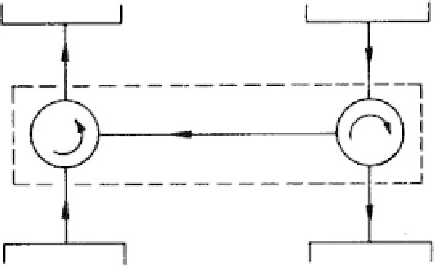Environmental Engineering Reference
In-Depth Information
T
H
T
A
Q
H
Q
A
2
W
HEAT ENGINE
REFRIGERATOR
Q
A
1
Q
L
T
L
T
A
Figure 16.2.1
Thermodynamic principle of the thermally-operated air-conditioning system (Grossman
and Johannsen, 1981).
thermo-electric collector (Thermal/Photovoltaic System) (Charalambous et al., 2007).
This concept had been described by Mittelman et al. (2007) and Kribus et al. (2006).
From a thermodynamic point of view, the system performance is dependent
on the thermal energy source temperature and on the cooling effect temperature
(Boehm, 1986). The system relies on ambient temperature conditions (Grossman
and Johannsen, 1981). Hence, system thermodynamic performance can be obtained
based on the system's operational temperature conditions (Abrahamsson and Jernqvist,
1993; Hellman, 2002). Thermally activated/operated systems have wide potential for
application, not only for buildings but also for other systems which produce ther-
mal energy (such as waste heat). Transportation and industrial sectors are sectors
with potential for thermally operated air-conditioning systems. Hence, Mazzei et al.
(2005) discuss the provision of thermal comfort of desiccant-based thermally activated
air-conditioning systems, which can save up to 50% conventional energy (Henning
et al., 2001). Thus, the system has potential for further development and application
through utilization of thermal energy resources and application of desiccant materials.
Figure 16.2.2 shows the operational concept of the desiccant-based air-conditioning
system. The processed air from the desiccant dehumidifier becomes hot due to the
release of heat through condensation and sorption. Heat recovery devices are used to
recover this energy for application again in the desiccant dehumidifier in conjunction
with other sources of thermal energy (renewable energy, non-conventional energy and
conventional energy). The condition of the air after the heat recovery becomes warm
and dry. In hot and humid climates, the air condition is still above the thermal comfort
temperature, so that an evaporative cooling process is applied by either direct addition
of air moisture (direct evaporative cooling) or indirect addition of air moisture in a
secondary air stream (indirect evaporative cooling). Furthermore, application of other
air cooling techniques, both conventional and non-conventional, can also be used as
an additional air cooler prior to introduction of the air to the indoor environment.
Conventional air coolers such as sorption chillers and vapour compression systems are
used with an increase in their performance. Non-conventional coolers, such as ground
source heat pumps and water source heat pumps, can also be used. These auxiliary

Search WWH ::

Custom Search